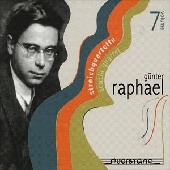
ESSENTIAL RECORDINGS

String Quartet No. 1 in E minor, Op. 5 (1924) String Quartet No. 2 in C major, Op. 9 (1925) String Quartet No. 6 in F major, Op. 54 (1946)
The music of German composer Günter Raphael (1903-1960), despite being impressive in nature and prolific in output, seems to have fallen through the cracks of desuetude over time. But proactive classical music labels like CPO and Querstand, of which this release is Volume 7 in their ongoing 'Raphael-Edition' series of recordings, are working hard at reviving his stature within the canon of 20th century music. By the age of ten, he was already seriously entrenched in the study of keyboard and orchestral works from the past centuries, and by eighteen had become a self-taught composer. So much so that some of his early composition teachers were at a loss to teach him something he didn't already know. By the late 1930s his professional life was profoundly curtailed by the Nazi regime when they classified him as being partially Jewish. Around the same time he became sick with tuberculosis, but despite many extended hospital stays and numerous operations, he continued to compose (including 5 symphonies) at a feverish pace. He succumbed to his illness when he was only 57 years old.
His harmonic language, though highly complex, remained rooted in tradition, but with a unique approach to thematic development. Even in his later years when he was flirting with 12-tone music, he insisted on defining it as "tonal 12-tone". He composed a total of ten works for string quartet, but only endorsed four for publication, three of which are on this new recording. Based on their discography, the Australian based members of the Acacia Quartet like to stray away from the tried-and-tested chamber music core repertoire, and the music of Günter Raphael certainly fits within their criteria.
The First Quartet opens with force and agitated determination as if to immediately make an impressive entrance, but quickly settles down to passages of highly lyrical beauty, and ends on a high note following an intricate and extensive a quatre fugal treatment. Oddly enough, the Second Quartet, written only a year later, sounds much more mature and anchored in tradition. Its expressive middle slow movement in particular seems to inhabit the sound world of 1880 Austria. And its final Tarantelle movement demands pinpoint rhythmic accuracy from all four players. The soaring lines of the first violin throughout the opening movement of the Quartet No. 6 are sure to grab your attention, as well as its highly evocative and melancholy laden slow movement.
The music of Günter Raphael may be highly individual and sometimes difficult to decipher, but as Lisa Stewart (violin), Myee Clohessy (violin), Stefan Duwe (viola) and Anna Martin-Scrase (cello) demonstrate, it is also full of warmth and human geniality. Highly worth exploring!
Jean-Yves Duperron - April 2020